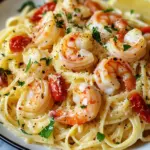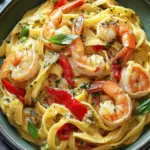Italian Easter Cookies are traditional, festive treats enjoyed during the Easter season, celebrated for their delicate, crisp texture and subtly sweet flavor accented with hints of lemon and vanilla. These cookies have long been a cherished part of Italian family traditions, symbolizing renewal and joy, and are often made in decorative shapes or adorned with festive sprinkles to mark the special occasion.
Full Recipe:
Ingredients
- 3 cups all-purpose flour
- ½ cup unsalted butter, softened
- ½ cup granulated sugar
- 3 large egg yolks
- 1 large egg
- 2 teaspoons baking powder
- ¼ teaspoon salt
- 1 teaspoon vanilla extract
- Zest of 1 lemon
- Optional: Colored sprinkles or a light dusting of powdered sugar for decoration
Directions
- Preheat oven to 350°F (175°C).
- Cream butter & sugar – Beat until light and fluffy.
- Add eggs – Mix in egg yolks, then the whole egg, until smooth.
- Flavor – Stir in vanilla extract and lemon zest.
- Mix dry ingredients – In a separate bowl, whisk flour, baking powder, and salt.
- Combine – Gradually blend dry ingredients into wet mixture until a smooth dough forms. Add extra flour if sticky.
- Roll & Cut – Roll dough to ¼-inch thickness on a floured surface. Cut into shapes.
- Arrange – Place cutouts on a parchment-lined or greased baking sheet.
- Bake for 10–12 minutes until edges turn lightly golden.
- Cool – Let cookies cool on the baking sheet for a few minutes, then transfer to a wire rack.
- Decorate (optional) – Sprinkle with powdered sugar or festive sprinkles.
Nutrients
- Calories: Approximately 110 per cookie (based on a yield of 24 cookies)
- Total Fat: 5g (of which Saturated Fat: 3g)
- Cholesterol: 40mg
- Sodium: 120mg
- Total Carbohydrates: 15g (Dietary Fiber: 1g, Sugars: 8g)
- Protein: 2g
History and Origins
The story of Italian Easter Cookies begins in a time when food was more than sustenance—it was an art form and a way to mark important events. Originating from various regions of Italy, these cookies were traditionally made during Easter as a way to celebrate the end of Lent, a period marked by abstinence and simplicity. After weeks of restraint, the arrival of Easter provided an opportunity for indulgence, and the cookies became a symbol of liberation and festivity. Over the centuries, each region contributed its own twist, incorporating local ingredients and unique decorative elements. The evolution of the recipe reflects Italy’s rich culinary diversity and the importance of seasonal celebrations, ensuring that each bite is imbued with historical significance and cultural pride.
Cultural Significance and Family Traditions
In Italian culture, food is inextricably linked with family and tradition. Italian Easter Cookies are often at the heart of holiday celebrations, bringing together family members who share the responsibility of baking and decorating these treats. The process is as important as the final product—a time when stories are exchanged, memories are made, and secret techniques are passed down from one generation to the next. This collaborative effort transforms baking into an event filled with laughter, learning, and love. The cookies themselves, frequently cut into festive shapes and adorned with delicate decorations, become cherished heirlooms that not only satisfy the palate but also serve as a reminder of the bonds that unite families and communities.
Traditional Preparation and Rituals
The traditional preparation of Italian Easter Cookies is a ritual in itself. Long before modern conveniences, families would gather in the kitchen to mix ingredients by hand, roll out the dough, and use intricately designed cutters to create patterns and shapes that were symbolic of the season. Each step of the process, from the careful creaming of butter and sugar to the gentle incorporation of egg yolks and zests, was performed with mindfulness and respect for the craft. This ritualistic approach instilled patience and a deep appreciation for the art of baking. Even today, many Italian families adhere to these time-honored methods, believing that the care and attention invested in every stage of preparation are reflected in the final taste and texture of the cookies.
Flavor Profile and Textural Elements
One of the most alluring qualities of Italian Easter Cookies is their refined flavor profile. The cookies boast a subtle sweetness that is delicately balanced by the fresh, zesty aroma of lemon and the warm undertones of vanilla. This harmonious blend creates a sophisticated taste that is both light and satisfying. Texturally, these cookies are celebrated for their perfect balance between crispness and tenderness. The exterior of the cookie offers a satisfying snap, while the interior crumbles delicately, melting in the mouth and leaving behind a lingering sweetness. This contrast in textures is achieved through precise measurements and careful baking, ensuring that every bite is a delightful experience that stimulates the senses.
Baking Techniques and Culinary Artistry
The creation of Italian Easter Cookies is a testament to culinary artistry. Traditional baking techniques, passed down through generations, emphasize the importance of precision and care. The process begins with the correct proportion of ingredients, ensuring that the dough achieves the ideal consistency—firm enough to be rolled thinly yet tender enough to yield a light, crisp cookie. Skillful bakers know that the resting period of the dough, the exact thickness to which it is rolled, and the careful selection of decorative cutters all play a crucial role in the final outcome. This meticulous approach transforms a simple mixture of butter, sugar, eggs, and flour into a work of art that is both visually striking and delicious. The dedication to technique is not only a celebration of the recipe itself but also an homage to the heritage and passion of Italian culinary traditions.
Creative Variations and Modern Adaptations
While traditional Italian Easter Cookies have a revered place in history, modern culinary enthusiasts have embraced the opportunity to experiment with creative variations. Contemporary bakers are infusing the classic recipe with new flavors, such as incorporating hints of almond or orange zest to add depth and complexity. Some innovative variations include the use of natural food dyes to create vibrant, festive colors, or the addition of finely ground nuts to introduce an extra layer of crunch and flavor. Despite these modern twists, the essence of the cookie remains intact—a delicate balance of flavor, texture, and cultural heritage. This fusion of tradition and innovation allows the cookies to appeal to both purists and new generations, ensuring that the recipe evolves while still honoring its roots.
Symbolism and Seasonal Celebrations
Easter is a time of rebirth, renewal, and hope, and Italian Easter Cookies embody these themes through both their appearance and flavor. The bright, cheerful colors often used in decorating the cookies mirror the vibrant blooms of spring, while the light, refreshing taste serves as a metaphor for the season’s promise of new beginnings. In many Italian communities, the cookies are a central part of the festive spread, symbolizing the end of winter and the welcoming of warmer, sunnier days. Their presence on the holiday table is a visual and gustatory reminder of the joy and abundance that the season represents. Each cookie, carefully crafted and beautifully decorated, becomes a small celebration of life—a token of the optimism and renewal that Easter brings.
Nutritional Considerations and Mindful Eating
Although Italian Easter Cookies are primarily cherished for their cultural and sensory appeal, they also offer insights into the traditional nutritional practices of Italian cuisine. Made with simple, wholesome ingredients, these cookies provide a modest source of energy and essential nutrients. The emphasis on quality over quantity in traditional recipes reflects a broader philosophy of balanced eating—a key tenet of Mediterranean dietary practices. While the cookies are undeniably a treat meant to be enjoyed in moderation, their simplicity also means they are free from the artificial additives that are common in modern processed foods. This commitment to natural ingredients and mindful preparation encourages an appreciation for food that is both nourishing and delightful, inviting bakers and consumers alike to savor each bite with gratitude and awareness.
Pairing and Serving Suggestions
Italian Easter Cookies are versatile in their presentation and can be enjoyed in a variety of ways. Traditionally served as part of an elaborate holiday spread, they pair beautifully with a range of beverages and accompaniments. A freshly brewed cup of espresso or a delicate herbal tea can complement the subtle flavors of the cookies, enhancing the overall sensory experience. In more elaborate settings, the cookies may be arranged on decorative platters and served alongside other seasonal treats such as candied fruits, biscotti, or a light, citrus-infused dessert. The versatility of these cookies makes them suitable not only as a dessert but also as a delightful snack during festive gatherings, providing a perfect balance of sweetness and texture that can be enjoyed at any time of the day.
The Role of Italian Easter Cookies in Cultural Heritage
Italian Easter Cookies are much more than a recipe—they are a cultural emblem that encapsulates the values, history, and traditions of Italian society. The act of preparing these cookies is often intertwined with family rituals and communal celebrations that reinforce social bonds and cultural identity. Each cookie carries with it a legacy of shared experiences and timeless customs, serving as an edible testament to the importance of heritage and tradition. For many, these cookies are a bridge connecting past and present, a tangible reminder of the enduring power of culinary art to preserve and transmit cultural values. As such, they occupy a cherished place not only in the realm of gastronomy but also in the collective memory of Italian communities worldwide.
Personal Reflections and Family Memories
For countless families, the tradition of baking Italian Easter Cookies is synonymous with cherished memories and personal milestones. The process of preparing these cookies often becomes an annual event marked by laughter, storytelling, and a deep sense of belonging. Many individuals recall the excitement of participating in the family baking ritual—rolling out the dough, using colorful cookie cutters, and eagerly awaiting the aroma of freshly baked treats wafting through the house. These experiences create a lasting imprint on the heart, turning a simple act of baking into a meaningful tradition that embodies the warmth and unity of family life. Over time, the cookies evolve into more than just a dessert; they become a symbol of shared heritage and the comforting continuity of family traditions passed down from generation to generation.
Modern Culinary Trends and the Preservation of Tradition
In today’s fast-paced world, there is a growing movement to rediscover and preserve traditional recipes that have withstood the test of time. Italian Easter Cookies are at the forefront of this trend, as modern bakers and culinary enthusiasts seek to reconnect with the art of traditional baking. Social media, food blogs, and cooking shows have played a pivotal role in reviving interest in these time-honored treats, inspiring a new generation to explore the history and techniques behind them. At the same time, the integration of modern ingredients and innovative methods has allowed the recipe to adapt to contemporary tastes without losing its authentic charm. This delicate balance between preservation and innovation not only keeps the tradition alive but also ensures that it remains relevant in a rapidly changing culinary landscape. The renewed focus on traditional recipes highlights a broader cultural shift towards valuing authenticity, sustainability, and the rich heritage embedded in every carefully crafted cookie.
Conclusion
In conclusion, Italian Easter Cookies are a celebration of tradition, artistry, and the enduring spirit of renewal that defines the Easter season. They encapsulate centuries of cultural heritage and familial love, offering a sensory experience that is as emotionally fulfilling as it is delicious. Through their delicate flavor, crisp texture, and beautiful presentation, these cookies not only mark the arrival of spring but also serve as a bridge between generations—a way to honor the past while embracing the future. As a cherished culinary tradition, they remind us that food is more than just nourishment; it is a medium through which we connect with our roots, celebrate life’s milestones, and share the joy of togetherness.






